Ferdinand Georg Waldmüller
Ferdinand Georg Waldmüller (Austrian German: [ˈfɛrdɪnand ˈɡeːɔrɡ ˈvaltmʏlɐ] ⓘ; 15 January 1793 – 23 August 1865) was an Austrian painter and writer. Waldmüller was one of the most important Austrian painters of the Biedermeier period.[1]
Ferdinand Georg Waldmüller | |
|---|---|
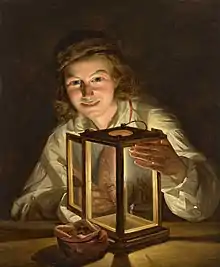 Self-portrait with a Lantern (1825; age 32). | |
| Born | 15 January 1793 Vienna |
| Died | 23 August 1865 (aged 72) Hinterbrühl |
| Nationality | Austrian |
| Education | Academy of Fine Arts Vienna |
| Known for | Painter, aquarellist and writer |
| Movement | Biedermeier Realism |
Career
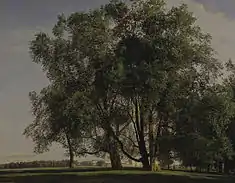
In 1807, Waldmüller attended the Academy of Fine Arts Vienna. He lived in Bratislava and, in 1811, he worked as a teacher of arts for the children of Count Gyulay in Croatia. He returned to the Academy of Vienna and studied portrait painting. In 1814 he married the singer Katharina Weidner, and subsequently went on tour with her, working as a set designer.[2]
In 1817, Waldmüller returned to Vienna and spent much time copying the works of old masters and painting portraits, genre subjects, and still-life. In 1823 he made a portrait of Ludwig van Beethoven. Waldmüller later became interested in nature and started painting landscapes, which in their loving attention to detail illustrate Waldmuller's belief that the close study of nature should be the basis of painting. These are his most notable works, in which his sense of colour and knowledge of nature helped him to achieve masterly skill.
In 1819, Waldmüller became professor at the Academy of Fine Arts Vienna, but was in disputes with the Viennese establishment, most notably for his comments on the system of the academy, where he wanted to establish a focus of the study on nature. His views were in opposition to the official doctrines of ideal art promulgated by the Vienna Academy, and after he had published his works on art education, he was forced to retire in 1857. By 1863 he had been accepted back into the art circles of Vienna, and was knighted in 1865.[2]
Ferdinand Georg Waldmüller was one of the most important Austrian painters of the Biedermeier period.[3] Whether it was the conquest of the landscape and thus the convincing rendering of closeness or distance, the accurate characterisation of the human face, the detailed and refined description of textures, or the depiction of rural everyday life: his works – brilliant, explanatory, moralising, and socially critical – influenced a whole generation of artists. Being an advocate of natural observation and plein air painting, as well as a critic of academic painting, Waldmüller was far ahead of his time.[1]
Waldmuller died on 23 August 1865 in Hinterbrühl, Austria.
Nazi-looted art
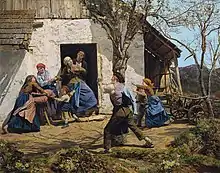
Waldmüller was one of Adolf Hitler's favorite artists.[4] Under the Nazis, 1933–1945, many artworks by Waldmüller were seized from Jewish collectors[5] and several were channeled to Hitler's Führer Museum in Linz.[6] Claims for restitution of looted Wadlmüller artworks include:
- Children on Their Way Home from School was stolen from Amalie Redlich in Nazi Austria.[7]
- Little Count Esterhazy was looted from the Bloch-Bauer collection.[8]
- "Bildnis der Familie Gierster" was stolen from Franz and Melania Popper.[9]
- Wiedergenesene was taken from Hermann Eissler.[10]
- Irma and Oscar Lowenstein for three Walmüllers seized under the anti-Jewish Nuremberg Laws for Hitler's planned Linz museum: The Good-Natured Child; Preparing the Celebration of the Wine Harvest, and The Grandparents’ Visit.[11]
Gallery
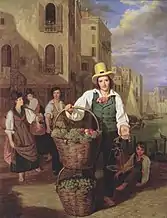 Venetian fruit seller (1826)
Venetian fruit seller (1826)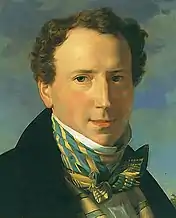 Ferdinand Georg Waldmüller—self-portrait, detail (1828; age 35)
Ferdinand Georg Waldmüller—self-portrait, detail (1828; age 35)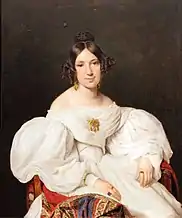 Louise Mayer (1836)
Louise Mayer (1836)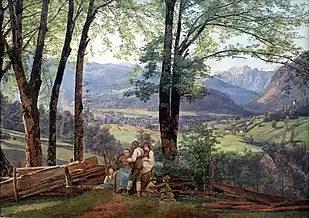 View of Ischl (1838)
View of Ischl (1838)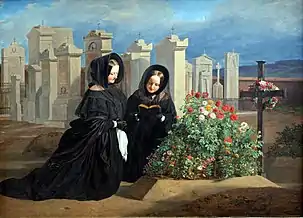 On All Souls' Day (1839)
On All Souls' Day (1839)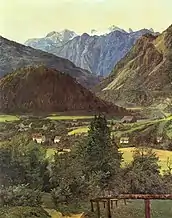 Dachstein (1839)
Dachstein (1839)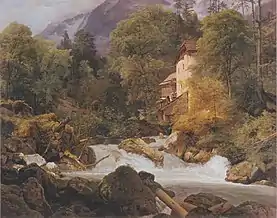 Waterfall (1840)
Waterfall (1840)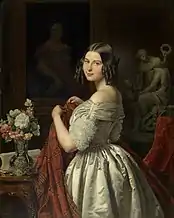 Young Lady (1840)
Young Lady (1840)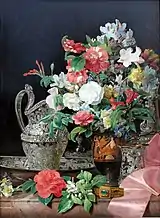 Still life with bouquet, silver vessels and antique vase (1840)
Still life with bouquet, silver vessels and antique vase (1840)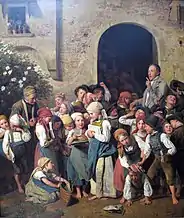 After school (1841)
After school (1841)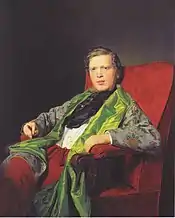 Emanuel Ritter von Neuwall (1841)
Emanuel Ritter von Neuwall (1841)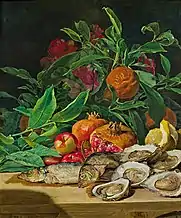 Still life with oysters, fish and exotic fruit (1842)
Still life with oysters, fish and exotic fruit (1842) Roses (1843)
Roses (1843)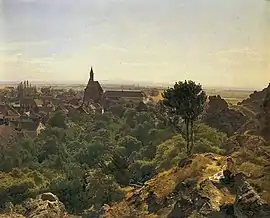 Sunny Day (1848)
Sunny Day (1848) The love letter (1849)
The love letter (1849).jpg.webp) Am Fronleichnamsmorgen (1857)
Am Fronleichnamsmorgen (1857)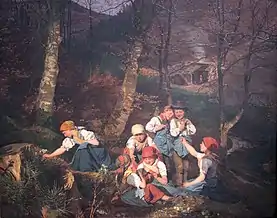 Children in a forest (1858)
Children in a forest (1858) Return from the Church Fair (1859)
Return from the Church Fair (1859)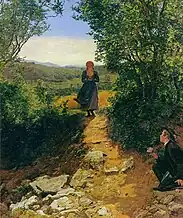 Die Erwartete (The Expected; 1860). This particular painting has been the subject of speculation among time travel enthusiasts who have claimed that the woman in the painting is holding an iPhone or similar example of modern technology. Art historians have pointed out that it is, in fact, a small prayer book common to the era.
Die Erwartete (The Expected; 1860). This particular painting has been the subject of speculation among time travel enthusiasts who have claimed that the woman in the painting is holding an iPhone or similar example of modern technology. Art historians have pointed out that it is, in fact, a small prayer book common to the era.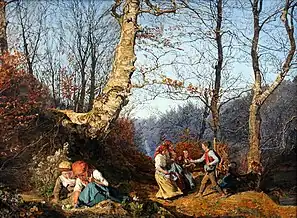 Early spring in Vienna forest (1864)
Early spring in Vienna forest (1864)
See also
References
- "Ferdinand Georg Waldmüller". belvedere.at. Archived from the original on 5 September 2015.
- Richard Rhoda Fine Art, Ferdinand Georg Waldmüller, (accessed 22 July 2014)
- "Ferdinand Georg Waldmuller Bibliography". Retrieved 7 December 2012.
- "Dealer With the Devil". Observer. 11 September 2007. Retrieved 1 May 2021.
Hitler wanted Portrait of a Young Lady by Ferdinand Georg Waldmüller, one of his favorite painters. And Kallir, willing or not, was the dealer who got it for him.
- "Lost Art Internet Database – Search". lostart.de. Retrieved 1 May 2021.
- "Art seized for Nazi museum finally finds its way home". lootedart.com. Retrieved 1 May 2021.
During her lifetime Irma Lowenstein was continually foiled in her mission to reclaim three paintings that had been seized from her Vienna apartment in the 1930s and were due to become part of Hitler's Führer Museum in Linz. Ms Lowenstein and her husband, Oscar, who ran a liberal newspaper in Austria, fled to Britain in 1938 and settled in London. He died shortly afterwards and she remarried and became Irma Austin. She then attempted to reclaim her possessions, including the three Ferdinand Georg Waldmüller paintings that had been seized under the anti-Jewish Nuremberg Laws.
- "Artworks stolen during Holocaust returned to families by Montreal museum". lootedart.com. Archived from the original on 10 August 2016. Retrieved 1 May 2021.
- "Woman in Gold: Altmann v. Republic of Austria and some documentation concerning the Bloch-Bauer collection". Victoria Sears Goldman. 2 April 2015. Retrieved 1 May 2021.
- "Restituiertes Waldmüller-Gemälde wird im Kinsky versteigert". DER STANDARD (in Austrian German). Retrieved 1 May 2021.
- "Kunstrückgabebeirat empfiehlt Rückgabe der 4 Apothekenschilder von Waldmüller". OTS.at (in German). Retrieved 1 May 2021.
- "Art seized for Nazi museum finally finds its way home". lootedart.com. Archived from the original on 4 January 2021. Retrieved 1 May 2021.
Bibliography
- Staff (15 June 2009). "Ferdinand Georg Waldmüller Retrospective Opens at The Belvedere". Art Daily.